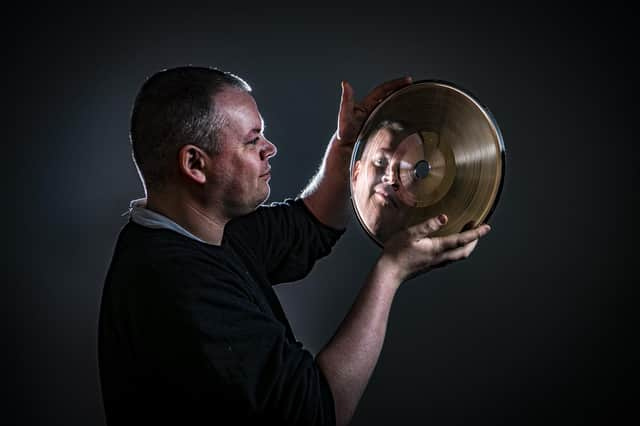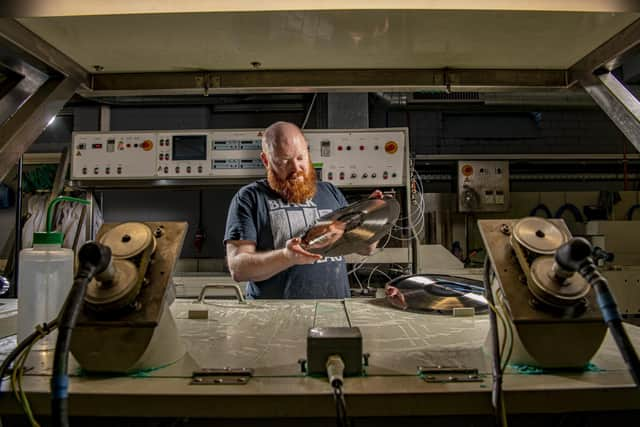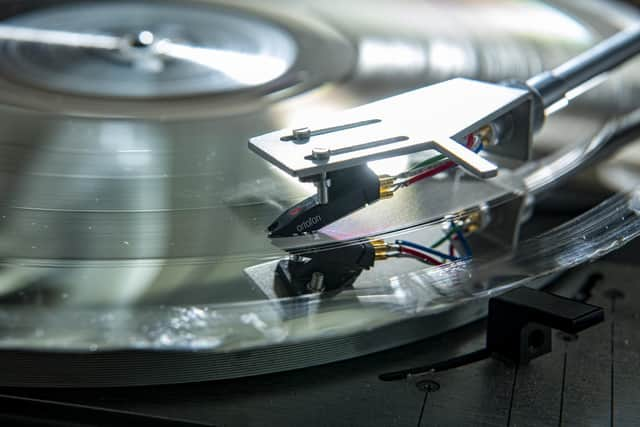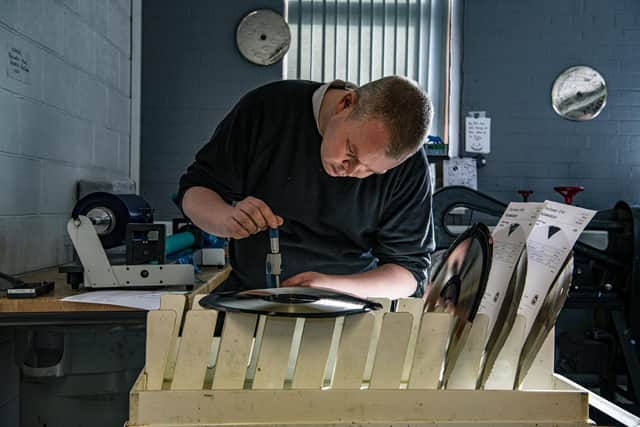Stamper Discs of Sheffield: The Yorkshire record factory benefitting from the vinyl revival and planning expansion


Back when CDs were shiny and new, the late DJ John Peel said: “Somebody was trying to tell me that CDs are better than vinyl because they don’t have any surface noise. I said, ‘Listen, mate, life has surface noise’.” And, yes, there is something about vinyl as the stylus lowers towards the spinning grooves and you anticipate the warm crackle of music. Fans of vinyl have never gone away, and sales are rising. New bands often release vinyl records alongside other formats, while some people still have their albums from decades ago.
An unseen side to vinyl can be found in an unremarkable unit on Carlisle Street East, Sheffield. Stamper Discs is not what you might expect. No records are cut or pressed here, but without the “electroforming” that Stamper does, no-one would be able to listen to vinyl.
Advertisement
Hide AdAdvertisement
Hide AdAs production director Martin Frings puts it: “I quite enjoy the fact that a little, non-descript industrial unit in Sheffield is doing all this work.”


Martin takes me on a tour of his small but noisy factory. “Let’s say you’re an artist or a label or a band and you want to get a record pressed,” he says. “Depending on where you are in the world, say you’re in Gothenburg and you want to use a plant in Gothenburg. You say, hello, here is my order and I want 4,000 records. Then most plants don’t do what we do. We’re a third-party trade service supplying record plants. They’ll then order the stampers for the job from us…”
As Martin talks, there is something almost organic about how he sees his work, with mentions of “mothers” and “growing” discs, as if this was an artisanal process rather than an industrial one.
He explains that in a cutting house, the recorded music is played on a cutting lathe that acts like a record player in reverse. This puts the music on to nitrocellulose, which is like “really thick nail polish”.
Advertisement
Hide AdAdvertisement
Hide Ad“The lathe has a stylus and the music that plays through the stylus vibrates and a heated diamond turns and creates the grooves,” says Martin.


These lacquers arrive at Stamper on an aluminium disc coated in nitrocellulose and can only be played two or three times. The company’s raw material is nickel, which comes in bags and looks like ball-bearings. Martin and his crew make a nickel copy of the fragile lacquer disc.
“The core of record making is a big hydraulic press, and the record looks like a hockey puck of soft PVC and then the grooves on a record you have at home are all valleys. They’re a positive, so the stamper we make is a copy of this but negative… if you run your fingers over the grooves on a stamper, it’s like a nail file. Essentially what you are doing on pressing is stamping the grooves on to PVC.”
That’s how the company got its name. “In hindsight it’s probably not the best name, it’s a bit like Ford calling themselves Car Company. But it works with the logo,” says Martin.
Advertisement
Hide AdAdvertisement
Hide AdThe lacquer discs are washed to remove dirt or grime that could end up as a “pop” on a record and are then coated with silver before being put into plating baths and electroplated with nickel, as happens with cutlery, although here the process is more refined. This silver coating makes the lacquer discs conductive, after which the silver is washed away from the nickel disc. Later, a hole is sunk exactly in the middle of the stamper. “If you’ve ever had a record and seen the stylus moving side to side, that means the record isn’t properly centred,” says Martin.


The discs are then cut to the size required by the pressing plant. After that the reverse side is sanded on a machine using different grades of sandpaper. This smooths the surface to ensure a good heat transfer on the press.
Stamper Discs has been in this unit for three years and is the only independent company in the UK doing such work. Fresh inquiries roll in every day, but Martin hasn’t been able to take on new customers since March last year. He plans to triple in size later this year by moving to a new factory site off Penistone Road.
At first Stamper was just Martin and his father, Peter, who is still a director. The firm employs five people, soon to be 15.
Advertisement
Hide AdAdvertisement
Hide AdMartin explains that the way the industry used to work was big plants, such as EMI, would do the print, press the record, make the stampers, and cut the lacquers “The market we serve is exclusively new wave pressing plants that have opened in the last ten years or so. They only have one or two or three presses, so they don’t have the know-how to do this, and can’t justify the expense.”
Stamper works for pressing plants around the world. “All sorts of music, everything from the biggest, from number one albums to a local punk band. We do a lot of southern French music because that’s where the customer is,” adds Martin.
There are three options at Stamper in the plating process. The first provides one stamper from the lacquer, enough to press around 1,000 records; the second creates an additional “mother” disc and allows for nine extra stampers and thus up to 10,000 records; and the third involves one “father” disc, up to 10 mothers, and can press up to 100,000 records.
Martin is not allowed to name names and occasionally must sign a non-disclosure order for work that is truly international. He runs through the latest orders. “This one is going to a customer in Copenhagen but that’s only a small order… Ireland, Milan, Stavanger in Norway, London... That’s off to Melbourne, New Zealand, another one in Italy, Wellingborough, Gothenburg.”
Advertisement
Hide AdAdvertisement
Hide AdLoving music is all part of the job. Martin is 32, started playing vinyl at 16 and now owns around 4,000 records. “Mainly punk stuff, I’m really into punk, and country, I listen to a lot of that.”
He tells me Andrew Smith has even more, up to about 7,000. Andrew, who is removing the silver layer from a disc to produce the nickel stamper, corrects that figure: “It’s more now. I am a punk at heart, but I really like Northern Soul, Motown.”
Andrew has been a vinyl DJ in Sheffield for 25 years. Working alongside him is Dale Miller, who builds his own electric guitar pedals, while Elsie Chadwick in customer service “goes to more gigs than anybody else,” according to the boss. “Mainly indie bands because they tour the most,” Elsie says. “But I like a bit of everything, I’m not fussy.”
It’s busy, precise work, everything thought through. The air pump that powers the silver guns has three additional filters, as any contamination could ruin the end-product. “A groove is only really around 50 microns. You can’t even see it with the naked eye, so you only need a speck of dust of ten microns to ruin it,” says Martin.
Advertisement
Hide AdAdvertisement
Hide AdThe water is lab-grade, as everything is specified within five microns – “a lot more than most aerospace industries,” says Martin.
Ladybower Reservoir in the Peak District supplies that water. “A very niche problem we have is that the water is really cold, so we have to heat the water back up in winter.”
As for Sheffield, Martin feels fortunate to work in a city with such an industrial heritage. “Any part you want made; someone will make it within ten miles. None of the machinery is off the shelf. It’s a godsend to be in Sheffield – everything we want can be made here.”
Comment Guidelines
National World encourages reader discussion on our stories. User feedback, insights and back-and-forth exchanges add a rich layer of context to reporting. Please review our Community Guidelines before commenting.